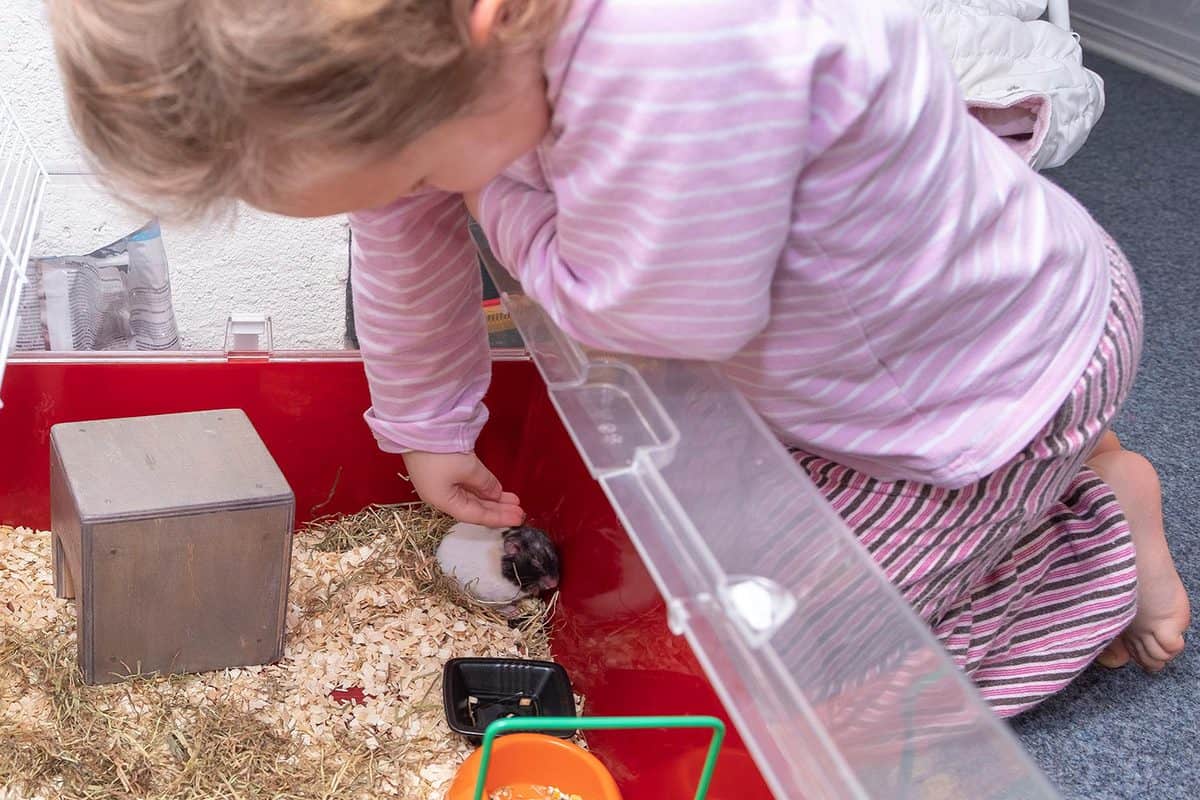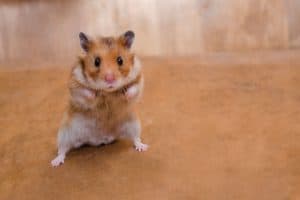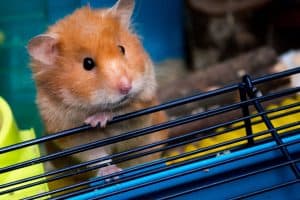 Do hamsters like to be petted? This might seem like a ridiculous question to the adoring hammie enthusiast, who might answer with a sardonic, “Do fish like water?” Surely the hamster, the ultimate in cuddly and affectionate animals, lives to be stroked, cuddled and otherwise petted by you, their adoring owner. And while this is mostly true, the fact is that hamsters—much like humans—only like to be touched at certain times, in specific ways and under certain conditions. In this article, we will teach you as a devoted and loving hamster owner just how to handle your hammie; how to properly pet the pet who brings you so much joy and affection in return.
Do hamsters like to be petted? This might seem like a ridiculous question to the adoring hammie enthusiast, who might answer with a sardonic, “Do fish like water?” Surely the hamster, the ultimate in cuddly and affectionate animals, lives to be stroked, cuddled and otherwise petted by you, their adoring owner. And while this is mostly true, the fact is that hamsters—much like humans—only like to be touched at certain times, in specific ways and under certain conditions. In this article, we will teach you as a devoted and loving hamster owner just how to handle your hammie; how to properly pet the pet who brings you so much joy and affection in return.
The simple answer to the question, “Do hamsters like to be petted?” is yes, absolutely. Hamsters, like the vast majority of pets, crave and desire attention from their owners. And for both you and your hammie, a petting session can mean a time of great bonding and relaxation; those few precious moments each day that you get to spend quality time with your beloved pet.
So yes, hamsters, in general, do like to be petted—yet not all the time, and not under all conditions. You also can master a certain, almost no-fail technique for the successful petting of a hamster. “Can’t we do anything in life these days without mastering some technique?” you might be wondering at this point, rolling your eyes heavenward. “Even pet our darned hamsters?” Point taken. Yet surely as a concerned pet owner, you want to pet your hamster in a manner that is safe and healthy for them, and that will not in any way harm or frighten them. Or, to put it another way: Pet your hamster in accordance with our guidelines, and you can greatly reduce your immediate likelihood of being hissed at, scratched or bitten—need we say more? Read on now for the complete guide to petting your hamster, as it applies to virtually all species of hamsters, including Syrian, dwarf/Roborovski and Siberian.
How Do I Pet My Hamster?

Is there some sort of scientific formula that applies to the petting of a hamster, of all things? Well no, but we can offer you a pretty much failproof step by step petting process that will enable you to handle your hammie in a manner that is safe and productive for both of you. This process is geared toward the nurturance and protection of the hamster, which is a delicate and sensitive creature in need of great and highly mindful care. With this in mind, please take the time to tutor both yourself and your family members (particularly any kids and teens in the house) in the proper and correct petting of a hamster. The suggested step by step process includes: • Cup your hamster in the cradle of your hand, placing your alternate hand on their back. • Run your middle and index fingers down the surface of the hamster’s back. • Pet the hamster with light, delicate strokes. • Avoid pressing down hard into the hamster’s fur or making sudden, jerky or swift moves. • Watch for any signs that your hamster is happy, relaxed, and enjoying the petting session. What are these signs, you inquire? Ah, we are so glad you asked….
How Do I Know My Hamster Likes Being Petted?

As you know, your hamster—although surely a brilliant and miraculous creature—cannot verbally convey their feelings to you. So if they do indeed appreciate your petting technique, your hammie have no means of flicking you a spirited paws-up sign and declaring, “Top job, Human! Keep it up!” Yet, in his/her own special ways, your hamster will indicate his/her overall approval of your ‘petting process.’ These include:
Chirps and happy squeaks
If your hamster reacts the same way to a pet as they do to a treat, chirping and squeaking to their heart’s content, then chances are you’re doing something right!
The relaxing of their facial features
Much like a contented cat, a hamster who enjoys being petted might narrow or close their eyes, tweak their nose, or wiggle their ears in a show of sheer elation.
The relaxing of their bodies
A well-petted hamster may lay and nestle deep in the palm of your hand; thus facilitating further petting and cuddling their thanks for your tender and well-administered affections.
Sleep
Lulled by your stroking motions, your hamster may fall right to sleep in your hand.
How Should I Pet a New Hamster?

Everything is new to the novice hamster owner. From the moment that you bring home your little bundle of furry joy, you no doubt are confronted with endless questions regarding their care. How do you feed your hamster? How do you clean him/her?
And how do you pet him/her?
Very carefully.
As a matter of fact, you may want to refrain from petting your hamster for the first few days of their presence in your home. Give them time to adapt to their surroundings before you make physical contact with them. Then, when you finally proceed to pet them, do so slowly and with great care.
Yep, we have a step by step procedure for that too. Are you surprised?
Here it goes:
- Start with short, light pats. As you feed or play with your hamster, you might lightly and gently pat his/her back; monitoring their reaction to this gesture.
- Refrain from any sudden or jerky moves. If you move too quickly or at harsh angles, you might frighten your hamster.
- Watch for any signs that your hamster is comfortable with the petting process, as outlined above.
- Similarly, also monitor your hamster for any signs that they are not pleased with being petted—not yet, anyway. What are these signs? Again, we are so glad you asked!
How Can You Tell If Your Hamster Doesn’t Like to Be Petted?
Just as your hamster cannot tell you that they quite favor your petting technique, they also can’t relate the opposite sentiment; that they would quite like you to quit and cut out all that infernal petting! Luckily, though, your hamster does have his/her own special ways of telling you to ixnay on the pet-nay.
These include:
- Hissing and sharp, repetitive squeaking. These are the sounds that hamsters generally make to express their fear, anger or dissatisfaction. If your hamster hisses or squeaks repeatedly while you are petting him/her, then cease all contact immediately.
- Biting, clawing and nipping. Squirming or running. If your hamster tries in some way to escape your grasp, then he/she may have a true aversion to petting.
Hamster Doesn’t Like Being Held:
How Can I Persuade My Hamster to Like Petting?
Petting is an important component of the bond that forms between a person and their pet. And while you should respect your hamster’s indications that they do not wish to be petted, you may be able to gently introduce them to the concept by:
- Holding your hammie. If you first hold your hamster in the palm of your hand, allowing them to explore and grow accustomed to your grasp, then they might become more amenable to the concept of petting.
- Patting before petting. Try gracing your hamster’s head with an occasional pat, before progressing to longer pets.
- Treats. Those who pet and treat simultaneously stand the best chance at success in this area!
If your hamster simply does not like to be petted, then you have many other ways to show them your love: speaking sweetly to them, giving them toys and treats, etc. Yet if you would like to make your precious hammie into a verified ‘lap hamster,’ then please learn the right way to pet your pet!




Hamsters absolutely do not like being held or petted, and they most certainly do not “crave and desire human affection”. This is patently false. Hamsters are solitary and nocturnal animals, and so they prefer to be left alone. They are highly likely to bite you if you attempt to pick one up, and will always squirm to try and escape your grasp, because they’re terrified and think you are a predator. Every time you attempt to pick up your pet hamster, you are inadvertently terrorizing them!
The closest thing achievable to what you describe here is acclimatization. Through constant handing from a young age, a hamster MIGHT learn to tolerate being held, and will not bite like they usually do. However, many experts agree that this is somewhat cruel, as you are not only forcing the animal to act unnaturally, but also to simply endure what is an unpleasant and frightening experience for them.
I am a veterinarian who specializes in exotics, which includes small mammals like hamsters. Please listen to me when I say that they are not naturally cuddly like a cat or a dog. They do not crave human interaction, and they do not enjoy it. It is unethical to spread misinformation like this, as it gives new and potential owners false hopes and expectations, and when they learn that the reality is quite different from what you have led them to believe, it will lead to an increase of abandoned and neglected hamsters.
Here’s the real truth about hamsters: Hamsters are not a domesticated animal like a dog or a cow; although they are bred in captivity, they are genetically identical to their wild counterparts, and still retain all of their wild instincts. We have only been breeding them for the pet trade for the last 80 years, and it takes thousands of years to fully domesticate an animal. The only thing pet hamsters have that sets them apart from their wild ancestors are their coat colors. Pet hamsters can come in several colors that do not exist in nature, as any rodent with a different fur pattern or color mutation stands out, and is easily seen by predators. Their wild nature is why pet hamsters make frequent attempts to escape their cages, and if successful, will oftentimes burrow into the walls of the home like any rat or mouse would. This is also why they do not particularly care for us humans. Their instinct is to be afraid of us, they become defensive if disturbed, and so will bite you upon reaching into the cage to take it out. For these reasons, a hamster should be considered as a “look only, do not touch” kind of pet, much like a goldfish or a crested gecko. Your hamster will be much, much happier and healthier for it!
Thank you very much for your input, Dr. Amelia! Our research indicates that they were first introduced as lab animals due to their tame nature. Many hamster owners seem to have a positive bond with their hammies too. However, it’s important to keep your perspective in mind, and we do appreciate it.
Three months ago I got a beautiful female Syrian hamster who is the sweetest thing! After bringing her home and letting her become familiar with her new home for a few days I then started to interact with her. She is now like clockwork, in the evening I will go in & say her name a few times & she comes right out of her house ready to be loved. If She wakes up before I’m there she sits in the same spot and waits for me. I hand feed her vegetables as well as her treats and she loves to come out of her cage & into her large play area where I am able to sit in it with her & crawls onto my legs up to my chest & have me love her. She lays on her back in my hands & loves a belly rub.
In my opinion if anything it would be cruel to leave her in a cage as Look but don’t touch pet.
Just saying…
I very much disagree. I’ve had more than 10 hamsters in my lifetime. I love them. I’ve only had one hamster who didn’t like to be petted, and it turned out she was sick. I definitely think hamsters like to be petted and played with.
This is not what I have experienced with mine at all. When I walk up to her cage and say “Daisy” she comes out to her door. I can hold out my hand and she will walk right into my palm. If I dont take her out of her cage often she starts to bite and naw at the bars. Thats when I know she is unhappy and wants to be taken out for a change of scenery. She crawls right on me and falls asleep. She is so sweet and I cant imagine not having a cuddle session with her or keeping her in her cage constantly. Sometimes she even stands with her paws up when im near the cage waiting for me to come and take her out for her evening cuddle.
@Amelia B DVM, My Syrian hamster turned very bold when he got used to us. I close the bathroom door and let my hamster down on the floor while hanging up laundry etc and he follows me around the room and runs towards whatever I put down on the floor to investigate it. I can often feel him trying to crawl up my legs and crawling over/sitting on my feet while I’m busy. I sit down on the floor with him sometimes and then he came crawling up me all on his own to sit on my shoulder for a bit… did it twice that evening as if it were a new hobby of his to climb the giant.
He got obsessed with the door when he got tired of the room and knew that that’s the way out so I had to push him away with my foot
when going in and out the door but he would try to ignore me and crawl over the foot, while I was pushing him, to reach the door in time.
He has escaped the bathroom a couple times in the night and both times he winds up in our bedroom of all places waking me up with the sounds of moving around. I wonder if he actually is looking for us. He should be scared of my husbands snooring.
He tolerates petting and me lifting him but I make sure I hand feed him often so he has no fear of my hand. I can’t tell if he likes petting, but I probably pet him too hard anyway. If hamster mothers clean their kids then I recon there should be a way to get them to enjoy petting. They’re not afraid of their mothers I presume.
@Krissi, my hamster is exactly like yours, she comes out and when we call her name with a nod of the head, she nods back and she really wants to come to us. She falls asleep in our hand and she enjoys above all being petted gently on the head, it which allows her to fall asleep against us.
She is in fact far more cuddly than the cat I had a few years ago!
And she never ever bit us. She once, when she was small, bit me by mistake because I had just cut a vegetable and my hands were smelling of that. I reacted with a sudden movement of my hand and since then, she has been extremely careful and never bit me again.
Me and my children love her so so much!
I highly agree with Amelia. I’ve had my hamster for a month now. Although she lets me pick her up and pet her, I could always tell she doesn’t like it, but rather just tolerates it. She loves to play outside of her cage and run around my body, but has never enjoyed being help or petted. Don’t think she ever will either.
https://youtu.be/DeQ_3bCcodk
You should watch this video
@Brooke, I suspect people take their hamsters out at the wrong time, at dyatime, when they’re supposed to be sleeping. And this way make them associate petting with being sleepy/falling asleep. Mine have rarely just sat still while me petting him, he’s far too busy exploring, and I have always watied until he was fully awake before letting him out of his cage.
My hamster is about 20 weeks old and loves to come out for a pet, she stands by her door and waits for my hand, she’s never nipped or hissed, I must be lucky!
Every Hamster is different, but in general I think that Hamsters become more used to being petted and enjoy this expression of the bond with their owners as time passes, and they come to trust you more. One of my Hamsters is more cuddly than the other one. I have had many Hamsters, and I strongly disagree with the person who says Hamsters don’t like being petted.
Those that insist hamsters do not like human touch are just unlucky and jealous that it never happens to them. It’s just like stereotyping a single independent middle aged woman who claims she doesn’t need anyone’s love but infact, craves for it but we outsiders will never know.
i love hamsters and also i very much disagree with the person who said hamsters do not like to be petted mine loves it and i do agree with the person who said “Those that insist hamsters do not like human touch are just unlucky and jealous that it never happens to them. It’s just like stereotyping a single independent middle aged woman who claims she doesn’t need anyone’s love but in fact craves for it but we outsiders will never know.”
My hamster is very expressive. He makes clicking noises when he is very happy. This happens sometimes when I dim the lights and pet him. He lets out a sharp squeak when he is annoyed. This happens sometimes if I pluck him out of bed in broad daylight to clean his home. If he wants to come out, he often walks right into my hand. If he doesn’t want my attention, he walks away from my hand quickly. I think most hamsters prefer no more than 20-30 minutes of interaction a day. But my hamster exhibits signs of distress if he doesn’t get attention once a day. Please make sure your hamster has a sand bath and a very minimum of 4000 square centimetres of space (50cm x 80cm). Please research how to be a humane hamster owner if you choose to take one in.
Hamsters are the best pet in the whole wide world.I’ve had five,
Female hamsters seem to be less cuddly than males. But I guess it depends
on the type .
Honestly, I think it probably depends on a combination of the type of hamster you choose (dwarves are often more twitchy), the sex of the hamster (females seem more active and less willing to sit still), and the individual personality of the hamster itself, whether it likes to be petted or not.
My Russian dwarf female dislikes being handled. She’s not afraid of my hand, because she readily comes out of her nest to investigate as soon as I stick my hand in the cage (she knows very well where the best treats come from, hahaha!), but as soon as I pick her up, she is squirming to get out of my grip. When she’s sleeping in her favorite spot outside her nest and I start gently petting her, she always gives me such an exasperated look before slowly, purposefully turning around and getting back into her nest. Basically, the relationship we have is one where she reluctantly tolerates my attentions in order to get more treats from me, hahaha!
My syrian scruff is definitely one of those hamsters that’s not so fond of petting. However he does love the opportunity to come out of his cage and run around on me and sniff everything. I think he’s too hyper to stay still for pets but will occasionally enjoy it if I pet right down by his nose and up his head. Not a place I’d thought a hamster would like but he does.
I saw someone say that hamsters don’t enjoy petting or human contact but my scruff loves attention. I left him at home for 2 months with my mother while I was away, she said he got grumpy and was refusing to come out of his cage and kept throwing his water bottle and food bowl. When I got home he was so happy to see me that when he heard my voice he came right out of his house and sat excitedly outside of the door for me. He stopped playing up the moment I was home. What I gathered from that, is not only do Syrians like people but they grow bonds with them and miss them too.